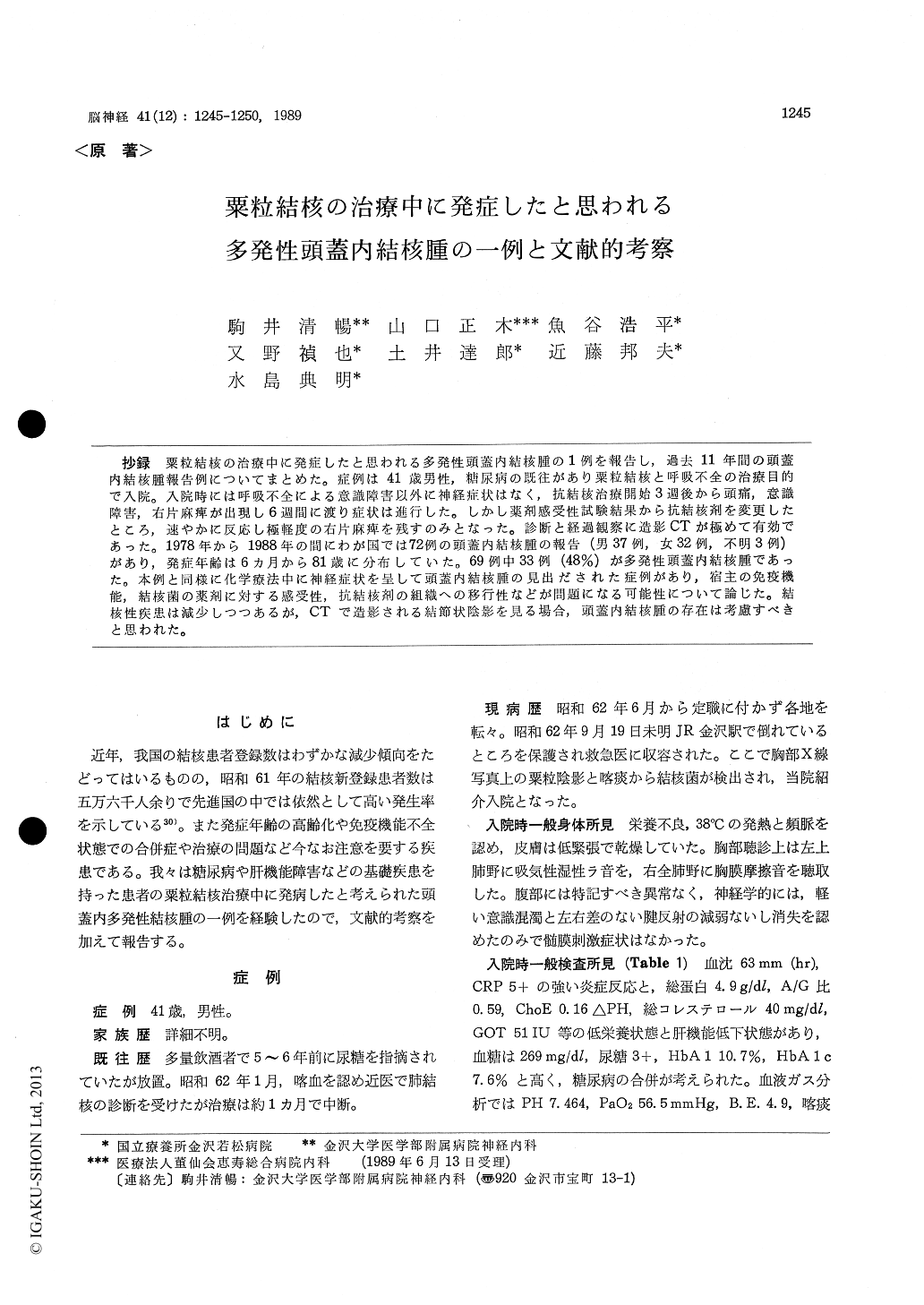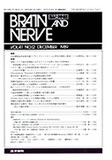Japanese
English
- 有料閲覧
- Abstract 文献概要
- 1ページ目 Look Inside
抄録 粟粒結核の治療中に発症したと思われる多発性頭蓋内結核腫の1例を報告し,過去11年間の頭蓋内結核腫報告例についてまとめた。症例は41歳男性,糖尿病の既往があり粟粒結核と呼吸不全の治療目的で入院。入院時には呼吸不全による意識障害以外に神経症状はなく,抗結核治療開始3週後から頭痛,意識障害,右片麻痺が出現し6週間に渡り症状は進行した。しかし薬剤感受性試験結果から抗結核剤を変更したところ,速やかに反応し極軽度の右片麻痺を残すのみとなった。診断と経過観察に造影CTが極めて有効であった。1978年から1988年の間にわが国では72例の頭蓋内結核腫の報告(男37例,女32例,不明3例)があり,発症年齢は6カ月から81歳に分布していた。69例中33例(48%)が多発性頭蓋内結核腫であった。本例と同様に化学療法中に神経症状を呈して頭蓋内結核腫の見出だされた症例があり,宿主の免疫機能,結核菌の薬剤に対する感受性,抗結核剤の組織への移行性などが問題になる可能性について論じた。結核性疾患は減少しつつあるが,CTで造影される結節状陰影を見る場合,頭蓋内結核腫の存在は考慮すべきと思われた。
We reported a case of multiple intracranial tuberculoma associated with milliary tuberculosis and reviewed the cases reported as intracranial tuberculoma in the past 11 years.
A 41-year-old diabetic man was admitted to our hospital for the treatment of milliary tuberculosis and respiratory insufficiency. On admisson, he had no neurological deficits except mild conscious-ness disturbance due to respiratory failure. He developed headache and mental confusion three weeks after the beginning of antituberculous the-rapy with isoniazid, streptomycin, rifampicin, and ethambutol. Neurological examination revealed that he had progressive right hemiparesis and was in a confusional state. Enhanced CT showedmultiple intracranial nodular lesions. During 6 weeks, he had progressive neurological manifes-tations in spite of his initial antituberculous treat-ment. He responded well, however, to the chemo-therapy with combination of isoniazid, kanamicin, pyrazinamide and ethionamide that were sensitive to tuberculous bacilli separated from his sputum. He became minimally righthemiparetic by 6 weeks after the change of antituberculous medication. Serial enhanced CT scan proved to be of great value in the diagnosis and follow-up study of in-tracranial tuberuloma.
From 1978 to 1988, there were 72 reported cases of intracranial tuberculoma in Japan ; 37 were male, 32 were female and 3 were uncertain because of no detailed document. The age of onset was distributed from 6 month to 81 years in age and 2 peaks were seen in the second decade and fifth to seventh decade. Thirty-three (48%) out of 69 cases had multiple intracranial lesions.
A few reports commented that neurological complications tended to appear even if they were under antituberculous therapy. Although many factors may nuderlie in such cases as ours, we suppose that potential factors include the host immunoreactivity, unsceptibility of tuberculous bacilli to chemotherapy, or penetration of antitu-berculous agents into brain tissue.
Although tuberculous diseases are diminishing in number in our country, we must take account of the existance of intracranial tuberculoma when we meet the enhancing nodular lesions on CT scan.

Copyright © 1989, Igaku-Shoin Ltd. All rights reserved.


